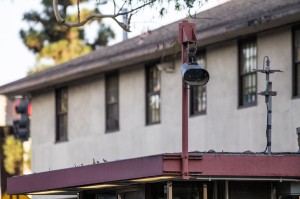On-campus cameras scan and report license plates
This past January, the USC Dept. of Public Safety installed 14 new license plate recognition cameras on and around campus. Since then, the cameras have gotten more than 500 hits, reporting license plates of lost or stolen cars that are wanted in connection with a crime.

Big brother · A camera watches over Gate 5 on Jefferson Boulevard and McClintock Avenue. DPS has installed 14 new license plate recognition cameras on campus and in the surrounding area since January. – Nick Entin | Daily Trojan
The cameras were installed as part of a multi-million dollar effort to enhance campus security measures. The new cameras work in tandem with 48 license plate readers that were installed in 2011 and 111 video patrol cameras, the first of which were installed in 2006.
“We strategically place them in the neighborhoods, and we also have them at every entrance to campus, so no car, theoretically, can come on or off campus without having their license plate scanned,” DPS Deputy Chief David Carlisle said.
The cameras scan every license plate that passes by them and run the numbers through a Department of Justice database, which determines if the license plate has been reported for any reason.
USC is one of few college campuses to use this technology. In a 2012 article from The New York Times, the University of Miami said they were considering adding license recognition cameras system, and an NBC affiliate in Wisconsin recently reported that police at the University of Wisconsin–Green Bay have begun testing the system with plans to implement it at the start of the 2014 school year.
Carlisle said the cameras are part of USC’s multilayered approach to campus safety that combines the use of DPS officers, private security and LAPD officers with technology to help keep students safe.
“We’re trying to minimize any spaces surrounding campus or on campus where a criminal could go without expecting to see law enforcement or be under the surveillance of law enforcement,” Carlisle said.
Through its partnership with USC, the LAPD has been able to make 36 LPR-related arrests since the original installation of the cameras in 2011, according to Carlisle.
Paul Snell, Captain of the LAPD Southwest Division, said the department’s partnership with USC has been extremely beneficial. He pointed to a recent case where a USC student left a party, got into a car with some men and was raped.
“The cameras themselves were useful in allowing us to identify who the suspects were and subsequently take them into custody for a rape investigation,” Snell said. “If we didn’t have that type of technology around campus we wouldn’t be able to make arrests or conduct these thorough investigations.”
USC’s resources often exceed those of municipal agencies. LAPD Southwest Division has four working LPR cameras that operate in police vehicles, scanning license plates as officers drive, but the division relies on USC to monitor the cameras surrounding campus and alert the LAPD of incidents. DPS has a communications office where officers are specifically trained to monitor a 72-screen unit that displays feeds from video patrol cameras and LPR cameras.
DPS Chief John Thomas credits predecessor Chief Carey Drayton for pushing to install the cameras.
“People that have been arrested as a result of the LPR and cameras have been people that have committed crimes away from the USC area,” Thomas said.
Junior mechanical engineering major Hannah Wilensky said that she and many other students were not aware of the LPR cameras but believes that they’re worth the cost as long as they remain useful.
“DPS does so much that we’re not aware of,” Wilensky said. “They have them there for a reason and they’re really effective. At the same time, if DPS makes [the information] public and [the cameras] start not becoming useful then I would worry.”
Still, freshman broadcast and digital journalism major Mirian Fuentes is concerned that the measures don’t have enough of a direct effect on students.
“It’s helpful but not enough to outweigh the cost,” Fuentes said.
Carlisle said that though students might not directly be aware of the direct benefits of the security measures, the hope is that criminals will become aware of security measures on campus and choose to go elsewhere.
Snell said he wishes the LAPD could be as well-equipped as USC but the partnership remains essential for the safety of the city as a whole.
“Technology is here and I think people are getting more and more used to it,” Snell said. “The importance that it brings to not only USC but to the Southwest Division in working together to solve crimes is huge.”

Seems a great idea
Who says we don’t.
When are we getting Predator drones?